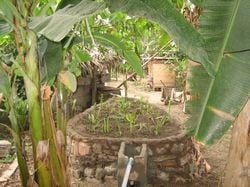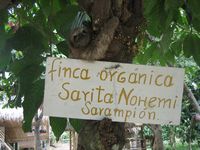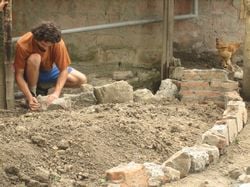

A detailed greywater system at Centro Orgánico Finca Sarita, an Ecuadorian seed saving center. This greywater treatment system was built in Ecuador, using a grease trapW as the first stage, followed by a gravel bed with native plants.
As a member of la Red de Guardianes de Semillas (the Seed Savers' Network), a grassroots Ecuadoran organization dedicated to the preservation of the traditional seed and the culture that it sustains, the Centro Orgánico Finca Sarita serves as a seed saving center for coastal Ecuador as well as an educational model in sustainable farming and ancestral living in its region.
Greywater filtration system[edit | edit source]

Along the lines of serving as a sustainable model within their community and region, coordinators of Finca Sarita were looking for a low-cost, model greywater filtration system built from local materials that could be easily maintained, repaired, and mimicked. Considering the region's abundance of native aquatic plants and its plethera of dirt and rocks, it seemed only appropriate to utilize a greywater marsh design to fill the coordinators' desires, this and no other center in la Red has incorporated this design into their model.
What's in a name?[edit | edit source]
Like la lagrima (the tear), this greywater system will purifica (purify) the very essence of that which sheds it. In this case, la lagrima purificadora (the purifying tear) will not only physically purifica the water leaving this thirteen sided kitchen, but it will also metaphorically purify the heart of this center, its hearth. In line with this ideology, this system's very shape is in the form of a teardrop.
Initial System[edit | edit source]
The center's initial greywater system, like that of many, consisted of a simple PVC pipe from the kitchen sink's drain to a mulched area. The smell wasn't horrendous, but it is clearly a breeding ground for unhealthy bacteria.
New System: La lagrima purificadora[edit | edit source]
In planning this system, the users of the kitchen estimated a daily water usage of approximately 50 gallons (190 L) of water per day, a very high estimation. This estimate includes all boiled drinking water and water for cooking, cleaning, and washing dishes. It was estimated that 35 gallons (130 L) of this would flow down the kitchen drain.
Our goal was to have the kitchen's waste water process for at least 72 hours in the greywater marsh. Considering that approximately 35 gallons might go down the drain per day, we needed our system to be able to hold 105 gallons of water at any given time.
Construction[edit | edit source]

Considering the layout of the proposed site, completely flat, and in order to maximize irrigation distance, it was clear that we would need to construct an above ground pond in order to gain any gravitational benefits.
The Base[edit | edit source]
With a plentiful supply of Holy stones and a good source of clay based soil, we went to work on creating a solid foundation. And why Holy, one might ask? The stones, which consisted of primarily urbanite (concrete and brick rubble) were salvaged from the recent demolition of the community church. With the new church well underway, it was commonly joked that holders of old stones will bless whatever they use them to construct, hence Holy stones.
The clay based soil was tamped into place in order to secure it and the lower rows of stone, forming a solid base from which to construct the walls.
With the foundation set, the exit pipe was put in place. The exit pipe is 3-inch PVC and leaves the marsh from the lowest place in the pond. The final height of the exit pipe will ultimately determine the water level of the marsh itself. The idea is that with one pull of the exit pipe, the entire marsh is easily drained, allowing for oxygen to reach the roots of the aquatic plants.
The Adobe[edit | edit source]
In order to strengthen the internal structure of the upper walls, an Adobe-like plaster was applied. Local grasses and clay based soil were hand harvested and feet mixed in order to create a natural fibrous plaster. This plaster was then applied as a structural coating to what would become a pool-like vessel awaiting its filling.
The Pond[edit | edit source]
Using the ancient method of leveling by the string and the eye, the pond's water level was determined. In order to secure this level, the exit pipe was cut at the desired height.
With an old salvaged, hole-less piece of doubled over plastic, an impermeable membrane created the pond base. From here a thin layer of sand was applied to cushion the weight of the following layers of gravel and stone.
As an experiment, large stones were placed towards the entry point, about one quarter of the pool, while gravel filled the rest. Our question is, in which medium do the roots of the aquatic plants prefer, the tight gravel or the loose stone?
With the stone and gravel in place, the aquatic plant hunt followed in suite. And shortly there after, the pipes were opened and the water rushed in.
The initial set of aquatic plants consisted of four distinct varieties, one of them the familiar Cattail (Typha). The idea behind the aquatic plants of course, is that their very oxygen producing nature, once established within the marsh, will filter out harmful bacteria in the water, resulting in mostly purified water that can be used for irrigation.
To baffle or not to baffle?[edit | edit source]
In designing a greywater marsh, one is forced to ask themselves how many baffles to incorporate in the system or should they be incorporated at all? The idea behind the baffle, a water road block of sorts, is to force the water either over or under the baffle, typically made of wood, on its way to the exit. The theory is that the bacteria filled water will be prohibited from picking one straight route to the exit, instead it will be forced to meander through more of the marsh, ideally more finely filtering the water.
In this design, we are experimenting with a baffle-less system. Our thought is that since the pond is constantly filled with water, routes will not be chosen, but rather all water molecules will be forced to meander due to the low-flow, low-movement nature of the marsh itself.
The Grease Trap[edit | edit source]
The 36 gallon grease trap and its preceding solids screen are this system's first components of filtration. Water leaving the kitchen sink is rarely alone, it is most often accompanied by food particles and, depending on cooking habits, grease.
In this system, water leaves the kitchen sink, passing through a removable food screen, and enters a double chambered grease trap, in the form of a brick box. The trap itself is divided into two chambers by a snuggly fit, removable board that sits two inches above the bottom of the box. The idea being that since grease floats, it will remain in the first chamber not able to advance to the second, while only water will pass through to the second chamber and beyond to the marsh. Both food in the solids trap and the grease will need to be cleaned on an as-needed basis.
The downside of this grease trap is that it stores, if even for only a short time, greywater, which can be a potentially harmful act. This problem has only been mitigated on a very basic level. For example, the design incorporates an easy release valve, which allows for a quick emptying of the grease trap. Also, we are currently testing the application of charcoal to see if it will prolong the time laps between emptying. Other ideas have been mentioned regarding mixing the bacteria infested water with wood chips similar to that of composting toilets. Ultimately however, this aspect of the system will need more attention.
The Exit[edit | edit source]
The exit pipe was designed in such a way that it would maximize the potential water height, for longer distance irrigation, while facilitating ease of draining. The pipe itself leaves from the lowest point in the pond and incorporates two ninety degree angle elbows, the second of which determines the ponds water level. In order to drain the pond, the vertical pipe is removed at the lowest elbow and an alternate pipe is installed, sending the water to the desired location.
Finishing Touches[edit | edit source]
In order to secure the aquatic plants and assure that the water level stays below the surface, more gravel and stone were added to a height three or four inches above the water. The idea is to not leave any exposed water that could harbor breeding grounds for mosquitoes.
With the plastic trimmed, more adobe plaster was applied in order to seal the connection between the plastic and the pond. And as a finishing touch, a final layer of soil was placed over the gravel to encourage the plants' surface root connections, as well as serving as a medium for native grasses.
When all was said and done, the pond, with its filling of stone and gravel, was calculated to hold approximately 175 gallons of water. This means that with the estimated 35 gallons of water heading down the drain per day, again a high estimation, theoretically each molecule of water will sit in the greywater marsh for approximately five days.






























